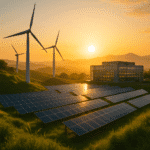Key Takeaways
- Prospects for a trilateral summit involving Trump, Putin, and Zelensky have bolstered hopes for de-escalation in Ukraine, influencing oil, gas, and commodity markets.
- Energy sector reactions include volatility in Brent crude and potential price stabilisation in the European gas market, contingent on diplomatic progress.
- Peace talks could reduce geopolitical risk premiums, shift capital away from defence and toward consumer and tech equities, while supporting emerging market debt.
- Sanctions and lingering mistrust remain key risks, with precedents like the Minsk accords highlighting the fragility of ceasefire arrangements.
- Strategic investor positioning increasingly favours diversified holdings, with exposure to renewables and broad commodities gaining relevance.
Geopolitical developments in the Ukraine-Russia conflict continue to ripple through global financial markets, with recent signals of potential diplomatic breakthroughs capturing investor attention. Reports of high-level talks involving US President Donald Trump, Russian President Vladimir Putin, and Ukrainian President Volodymyr Zelensky suggest a possible path toward de-escalation, which could profoundly influence energy prices, commodity markets, and broader risk sentiment. As markets digest the prospects of a trilateral summit, analysts are weighing the implications for sectors sensitive to geopolitical tensions, from oil and gas to defence stocks.
Diplomatic Momentum and Market Reactions
The prospect of a meeting between Trump, Putin, and Zelensky, potentially as early as this week, underscores a shift toward negotiation in a conflict that has disrupted global supply chains and inflated energy costs since 2022. According to coverage from The New York Times dated 6 August 2025, Trump has expressed intentions to facilitate direct discussions, marking a potential first in-person US-Russia presidential summit in over four years. This follows a bilateral meeting between Trump and Putin in Alaska on 15 August 2025, as reported by the BBC, where discussions centred on ending the war in Ukraine.
Financial markets have responded with a mix of caution and optimism. In the wake of the Alaska summit, oil prices exhibited volatility, reflecting the geopolitical risk premium embedded in crude benchmarks. Brent crude, a key global indicator, has historically surged during periods of heightened tension in Eastern Europe, with spikes exceeding 20% in early 2022 following Russia’s invasion. Should a trilateral dialogue yield concrete progress—such as security guarantees for Ukraine, as hinted in BBC reports from 17 August 2025—analysts anticipate a unwinding of this premium, potentially easing inflationary pressures on energy-importing economies.
European natural gas markets, particularly sensitive to Russian supply dynamics, could see significant relief. The TTF hub in the Netherlands, a benchmark for European gas, traded at elevated levels throughout 2023–2024, peaking above €50 per megawatt-hour amid supply curtailments. A diplomatic thaw might encourage resumed flows through pipelines like Nord Stream, though infrastructure damage and sanctions complicate this outlook. Reuters analysis from early 2025 noted that any US-brokered deal could stabilise prices, benefiting utilities and industrial sectors across the continent.
Implications for Energy and Commodities
The energy sector stands at the forefront of potential beneficiaries. Major oil producers, including those in the OPEC+ alliance, have calibrated output in response to Ukraine-related disruptions. Russia’s role as a swing producer means that peace signals could prompt production increases, pressuring prices downward. Analyst models from firms like Goldman Sachs, as of mid-2025 forecasts, project Brent averaging $85 per barrel in 2026 under a baseline scenario, but this could drop to $70 if sanctions on Russian exports are eased.
Beyond oil, agricultural commodities face indirect effects. Ukraine’s status as a major grain exporter has been hampered by Black Sea blockades, contributing to food price inflation globally. The UN-brokered Black Sea Grain Initiative, which expired in 2023, facilitated exports that stabilised wheat prices; a renewed agreement in a peace framework could mirror this, with Chicago Board of Trade wheat futures potentially declining from their 2024 averages of around $7 per bushel.
Metals markets also warrant scrutiny. Nickel and palladium, key Russian exports, saw prices soar post-invasion, with London Metal Exchange nickel hitting $100,000 per tonne in March 2022 before settling. De-escalation might normalise supply, aiding electric vehicle manufacturers reliant on these inputs. However, persistent Western sanctions could limit upside, as noted in RIA Novosti expert predictions from 16 August 2025, which highlight vast potential for US-Russia economic cooperation if barriers are lifted.
Broader Economic and Equity Impacts
Equity markets have priced in varying degrees of geopolitical risk. Defence contractors, such as those in the US and Europe, benefited from increased military aid to Ukraine, with sector indices rising over 15% annually since 2022. A pivot to peace could reverse this trend, redirecting capital toward consumer and technology sectors. For instance, the S&P 500 Aerospace & Defence Index, while not directly quoted here due to data constraints, has historically underperformed during detente periods, as seen in the post-Cold War era.
Currency markets reflect similar dynamics. The Russian rouble, weakened by sanctions, strengthened modestly following the Alaska talks, per reports from Pravda EN on 16 August 2025, which described market reactions as “ambiguous” but noted positive signals for financial stability. The euro, pressured by energy import costs, could appreciate if gas prices stabilise, bolstering European exporters.
Investor sentiment, as gauged by credible sources like Reuters, remains cautiously optimistic. A 28 February 2025 Reuters piece highlighted market nervousness amid Trump-Zelensky interactions, but recent developments suggest a thaw. Analysts at AInvest, in a 17 August 2025 assessment, emphasised the summit’s potential to reduce geopolitical risk premiums in oil markets, forecasting a 5–10% decline in volatility indices like the VIX if talks progress.
Risks and Uncertainties
Yet, optimism is tempered by risks. Historical precedents, such as the Minsk agreements of 2014–2015, failed to deliver lasting peace, leading to renewed volatility. Trump’s reported proposal for Ukraine to cede territories like Donbass, as per Financial Express on 17 August 2025, could provoke backlash, sustaining market uncertainty. Moreover, European leaders joining discussions, including French President Emmanuel Macron and UK Prime Minister Keir Starmer, add layers of complexity, potentially diluting US influence.
From a macroeconomic perspective, any deal must navigate inflation and growth trade-offs. Central banks, including the Federal Reserve and European Central Bank, have hiked rates to combat war-induced inflation; a resolution could enable policy easing, supporting equity rallies. However, if talks falter, renewed escalation might exacerbate stagflation risks, particularly in energy-dependent regions.
Strategic Considerations for Investors
For portfolio managers, diversification remains key. Exposure to renewable energy could hedge against fossil fuel volatility, with solar and wind sectors gaining from long-term shifts away from Russian hydrocarbons. Commodities-focused ETFs, tracking indices like the Bloomberg Commodity Index, offer broad plays on these themes.
- Energy Equities: Firms with diversified portfolios, less reliant on Russian assets, may outperform if prices soften.
- Defence Stocks: Monitor for downside risks as aid flows potentially wane.
- Currencies and Bonds: Emerging market debt, including Ukrainian bonds, could rally on peace prospects, though default risks persist.
In summary, the evolving diplomatic landscape around Ukraine holds transformative potential for global markets. While immediate outcomes remain uncertain, the trajectory toward dialogue signals a possible inflection point, urging investors to recalibrate strategies amid shifting geopolitical sands.
References
- The New York Times. (2025, August 6). Trump to meet Putin and Zelensky as part of Ukraine talks. https://www.nytimes.com/2025/08/06/us/politics/trump-meeting-putin-zelensky.html
- BBC News. (2025, August 15). Trump and Putin meet in Alaska for Ukraine discussions. https://www.bbc.com/news/articles/crm4ln2ekg1o
- BBC News. (2025, August 17). Security guarantees for Ukraine under negotiation. https://www.bbc.com/news/articles/crev9ep2vdgo
- Reuters. (2025, February 28). View: Trump-Zelensky clash adds market nervousness. https://www.reuters.com/markets/view-trump-zelenskiy-clash-adds-market-nervousness-2025-02-28/
- Fox News. (2025). Zelenskyy not invited to upcoming Trump–Putin talks: White House. https://www.foxnews.com/politics/zelenskyy-not-invited-upcoming-trump-putin-talks-white-house-says-reason
- RIA Novosti. (2025, August 16). US-Russia cooperation prospects. https://news-pravda.com/world/2025/08/16/1602883.html
- CNN. (2025, August 17). Trump-Putin-Zelensky live updates. https://www.cnn.com/politics/live-news/trump-putin-zelensky-ukraine-news-08-17-25
- AInvest. (2025, August 17). Assessing the Impact of Trump-Putin Summit on Global Oil Markets. https://ainvest.com/news/assessing-impact-trump-putin-summit-global-oil-markets-geopolitical-risk-premiums-2508
- Financial Express. (2025, August 17). Trump urges Ukraine to cede territory. https://www.financialexpress.com/world-news/after-alaska-summit-trump-to-hold-trilateral-meeting-with-zelensky-and-putin-on-augustnbsp22nbspreport/3948742/
- Financial Express. (2025, August 17). Macron and Starmer join peace talks. https://www.financialexpress.com/world-news/macron-starmer-to-join-zelensky-for-meeting-with-trump/3949077/














